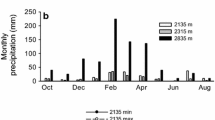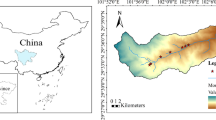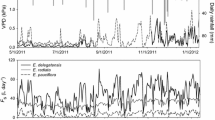Summary
The daily temperature and water relations of 7 perennial subalpine, understory species (1 shrub, 1 subshrub, 5 herbs) were compared in the Rocky Mountains of southeastern Wyoming with an emphasis on the effects of natural sun and shade exposure. Field measurements of rainfall; leaf, air, and soil temperatures; stomatal conductance to water vapor diffusion; and plant and soil water potentials were supplemented with leaf and root morphological measurements to evaluate potential adaptive patterns in understory species.
Morphologically, all 7 species had relatively broad leaves that were hypostomous and bicolored with the abaxial leaf surface lighter than the abaxial surface. Root systems tended to be shallow (<20 cm), especially for the herbaceous species. Although soil water potentials from 4 to 40 cm depths remained relatively high throughout the summer (>-1.0 MPa), plant xylem water potentials for sunlit plants decreased to below-2.0 MPa during midday. During these sunlit periods, leaf temperatures and conductances increased substantially, leading to severe wilting for 4 of the 5 herbaceous species. Stomatal conductance and density for 6 of the 7 species monitored were much greater on abaxial compared to adaxial leaf sides and substantial stomatal closure occurred when either leaf side was oriented to receive direct sunlight. Moreover, stomatal opening on abaxial leaf sides corresponded to the amount of sunlight incident upon the adaxial rather than abaxial leaf surfaces. The 2 shrubby species did not wilt during these periods and were characterized by the highest leaf temperatures (>30°C). These 2 species also had consistantly lower xylem water potentials throughout the summer growth period. These results are discussed in terms of the possible adaptive significance of midday wilting, leaf hypostomy and bicoloration and stomatal behavior to the water and photosynthetic relations of understory species.
Similar content being viewed by others
References
Anderson MC (1966) Some problems of simple characterization of the light climate in plant communities. In: R Bainbridge, GC Evans, O Rackham (eds) Light as an ecological factor. Blackwell Scientific Pub. Oxford, p 77–90
Anderson RC, Loucks OL, Swain AM (1969) Herbaceous response to canopy cover, light intensity, and throughfall precipitation in coniferous forests. Ecology 50:255–263
Bjorkman O, Ludlow MM (1972) Characterization of the light climate on the floor of a Queensland rainforest. Carnegie Institute of Washington, Yearbook 71:85–94
Boynton WP, Brattain WH (1929) Interdiffusion of gasses and vapors. Intern Critical Tables 5:62–64
Bray JR (1958) The distribution of savanna species in relation to light intensity. Can J Bot 36:671–681
Elias P (1979) Leaf diffusion resistance in an Oak-Hornbeam forest. Biologia Plantarum 21:1–8
Evans GC (1956) An area survey method of investigating the distribution of light intensity in woodlands with particular reference to sunflecks. J Ecol 44:391–428
Evans GC, Coombe DE (1959) Hemispherical and woodland canopy photography and the light climate. J Ecol 47:103–113
Hadfield W (1975) The effect of high temperatures on some aspects of the physiology and cultivation of the tea bush, Camellia sinensis, in North East India. In: GC Evans, R Bainbridge, O Rackham (eds) Light as an ecological factor: II. Blackwell Scientific Pub, Oxford London Edinburgh Melbourne, p 477–495
Heichel GH, Anagnostakis SL (1978) Stomatal response to light of Solanum pennellii, Lycopersicon esculentum, and a graft-induced Chimera. Plant Physiol 62:387–390
Kriedmann PE, Torokfalvy E, Smart RE (1973) Natural occurrence and photosynthesis utilization of sunflecks by grapevine leaves. Photosynthetica 7:18–27
Lakso AN, Barnes JE (1978) Apple leaf photosynthesis in alternating light. Hortscience 13:473–474
Lundegarh H (1922) Zur Physiologie und Okologie der Kohlensäureassimilation. Biol Zbl 42:337–358
McCree KJ, Loomis RS (1969) Photosynthesis in fluctuating light. Ecology 50:422–428
Nelson BE (1978) Vascular plants of the Medicine Bow Mountains, Wyoming. University of Wyoming, Laramie: Rocky Mountain Herbarium
Nobel PS (1974) Introduction to biophysical plant physiology. WH Freeman and Co. San Francisco, California, USA
Nobel PS (1977) Internal leaf area and cellular CO2 resistance: photosynthetic implications of various growth conditions and plant species. Physiol Plant 40:137–144
Norman JM, Miller EE, Tanner CB (1971) Light intensity and sunfleck size distributions in plant canopies. Agronomy Journal 63:743–748
Parkhurst DF (1978) The adaptive significance of stomatal occurrance on one or both surfaces of leaves. J Ecol 66:367–383
Pollard DFW (1970) The effect of rapidly changing light on the rate of photosynthesis in largetoth aspen (Populus grandidentata). Canadian Journal of Botany 48:823–829
Rackham O (1966) Radiation, transpiration, and growth in a woodland annual. In: R Bainbridge, GC Evans, O Rackham (eds) Light as an ecological factor. Blackwell Scientific Pub. Oxford, p 167–185
Rackham O (1975) Temperatures of plant communities as measured by pyrometric and other methods. In: GC Evans, R Bainbridge, O Rackham (eds) Light as an ecological factor: II. Blackwell Scientific Pub, Oxford London Edinburgh Melbourne, p 423–449
Rechard PA, Smith VE (1972) Physical and hydrometeorological characteristics of the Snowy Range Water Resources Observatory. Water Resources Series No. 31, Research Institute, University of Wyoming, Laramie
Reifsnyder WE (1966) Forest meterology: the forest energy balance. Intern Rev Forestry Res 2:127–129
Reifsnyder WE, Furnival GM, Horowitz JL (1971) Spatial and temporal distribution of solar radiation beneath forest canopies. Agric Met 9:21–37
Smith WK, Nobel PS (1978) Influence of irradiation, soil water potential, and leaf temperature of leaf morphology of a desert broadleaf, Encelia farinosa Gray (Compositae). Am J Bot 65:429–432
Taylor SE (1975) Optimal leaf form. In: DM Gates, RB Schmerl (eds) Perspectives of biophysical ecology. Springer, Berlin Heidelberg New York, p 73–83
Turner NC (1970) Response of adaxial and abaxial stomata to light. New Phytol 69:647–653
Young DR, Smith WK (1979) Influence of sunflecks on the temperature and water relations of two subalpine understory congeners. Oecologia (Berl) 43:195–205
Young DR, Smith WK (1980) Influence of sunlight on photosynthesis, water relations, and leaf structure in the understory species Arnica cordifolia. Ecology, in press
Author information
Authors and Affiliations
Rights and permissions
About this article
Cite this article
Smith, W.K. Temperature and water relation patterns in subalpine understory plants. Oecologia 48, 353–359 (1981). https://doi.org/10.1007/BF00346494
Received:
Issue Date:
DOI: https://doi.org/10.1007/BF00346494




